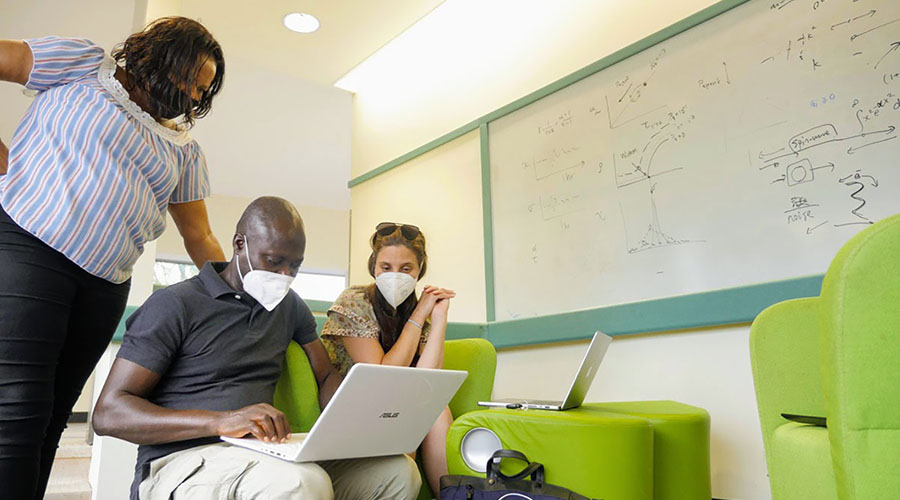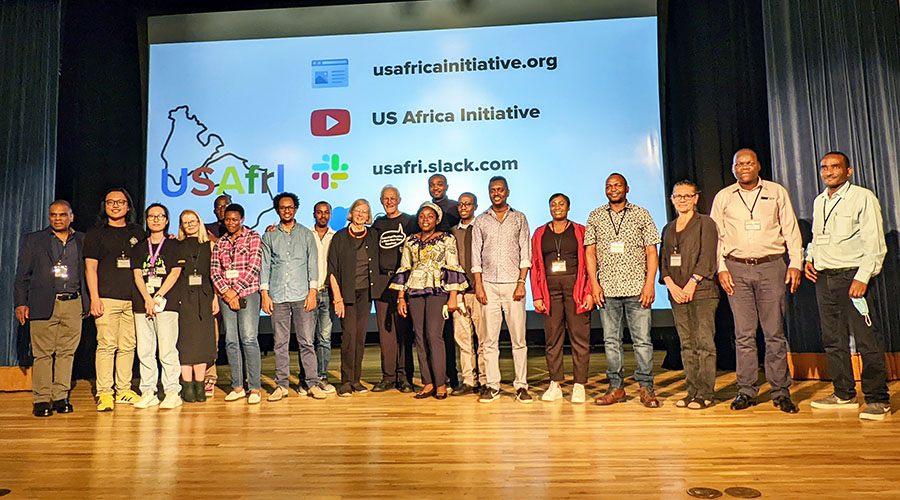
July/August 2023 (Volume 32, Number 7)
APS Innovation Fund Supports “Vibrant” US-Africa Collaborations in Modeling Electronic Structure
Despite the pandemic, travel restrictions, and even armed conflict, partnerships between researchers in the US and Africa persist.
By Liz Boatman | June 15, 2023

Credit: Amy Young
From left to right, Winfred Mueni Mulwa from Egerton University in Kenya and Bamidele Ibrahim Adetunji from Bells University of Technology in Nigeria collaborate with Elif Ertekin at the University of Illinois, Urbana-Champaign, in 2022. The visit was borne out of USAfrI, an initiative supported by the APS Innovation Fund.
Richard Martin, a professor emeritus in physics at the University of Illinois, Urbana-Champaign (UIUC), first met Nithaya Chetty in 1987. Chetty was a graduate student who had come to the US as a Fulbright Fellow, an achievement for a young Black scientist who had grown up during apartheid in South Africa. Just three years later, Chetty earned his doctorate for research on semiconductor surfaces as a student in Martin’s group. In 1995, after apartheid ended, Chetty returned to his home country, intent on supporting other young South Africans. Today, he is the Dean of the Faculty of Science at the University of the Witwatersrand in Johannesburg.
Chetty and Martin’s work together was far from over. In 2008, Chetty founded a workshop series called the African School on Electronic Structure Methods and Applications, or ASESMA; roughly 30 African students and faculty attended its inaugural event in Cape Town. Martin, who retired the same year, joined the effort and has helped Chetty organize ASESMA ever since.
In 2019, Martin — eager to do more to support African scientists’ work — teamed up with Renata Wentzcovitch, who had given a seminar at the 2012 ASESMA workshop. Wentzcovitch, originally from Brazil and now a professor of physics and environmental science at Columbia University in New York, had stumbled upon the APS Innovation Fund and seen an opportunity to organize workshops that would foster long-term collaborations between African and US-based electronic structure researchers.
Wentzcovitch brought on two more partners: Sinéad Griffin, a staff scientist at California’s Lawrence Berkeley National Laboratory (Berkeley Lab) and a passionate supporter of ASESMA’s efforts, and Omololu Akin-Ojo, director of the ICTP East African Institute for Fundamental Research (ICTP-EAIFR) in Rwanda.
They applied to the APS Innovation Fund, received a grant of $138,000, and launched the US-Africa Initiative for Electronic Structure, or USAfrI. “The ability to jumpstart collaborations with the APS Innovation Fund was just wonderful,” says Martin.
But within months, the COVID-19 pandemic had begun to derail plans, forcing online a series of workshops that the team had hoped to hold in-person. Still, the travel restrictions had a silver lining: Because COVID normalized virtual meetings, participation in USAfrI activities expanded. Scientists from across Africa and North America logged on for four virtual workshops over two years.
The project culminated in 2022, when 15 African faculty came to the US for an in-person, multi-week visit. That June, scientists from Cameroon, the Democratic Republic of the Congo, Ghana, Ethiopia, Kenya, Nigeria, Rwanda, South Africa, and Tanzania — visas in-hand and travel restrictions eased — boarded flights to New York City.
ICTP-EAIFR’s status as a physics hub in Africa contributed to the team’s success in bringing together scientists from across the continent, says Akin-Ojo.
In the US, the researchers attended the Annual Workshop on Recent Developments in Electronic Structure, held at Columbia that year. Then they spent a day touring Brookhaven National Laboratory, where they learned about opportunities for virtual access to the lab’s supercomputing facilities, which researchers anywhere in the world can apply to use.

Credit: Michael Martin
In 2022, 15 faculty from African institutions visited the US, a culminating event of USAfrI.
Afterward, the researchers boarded planes once again, but not to return home. Instead, they dispersed across the US to spend several weeks at institutions where researchers had volunteered to host them — including UIUC, Columbia, Brookhaven and Berkeley National Labs, Cornell University, Rutgers University, Stanford University, the University of California at Berkeley, the University of Colorado, the El Paso and Dallas campuses of the University of Texas, the University of Washington, and the University of Western Washington. Amy Young at UIUC was instrumental in coordinating these activities, says Wentzcovitch.
“It worked out very well,” says Akin-Ojo, and led to incredible collaborations. For example, Adewumi Popoola, a physicist at the Federal University of Technology in Nigeria, just published a paper on narrow band-gap compounds for use in thermoelectrics with Robert DiStasio, a collaborator at Columbia. And Qin Wu and Deya Lu at Brookhaven have continued to support Yedilfana Mekonnen at Addis Ababa University in Ethiopia with remote access to the lab’s computing facilities.
For researchers from less-resourced institutions, “people should know just how much stamina and personal strength it takes . . . to participate in an international collaboration,” says Martin. And some African scientists are trying to sustain their research in the face of serious conflict, he says — like Sara Abass at the Al Neelain University in Sudan, who is collaborating with André Schleife, a materials scientist at UIUC. The two have stayed in touch, even though in April 2023, competing armed forces launched a battle to assume control of Sudan’s capital, Khartoum, where Abass lives.
Despite the challenges, “the APS Innovation Fund really helped us to broaden the US-based community that interacts with African researchers,” Wentzcovitch says. More than 100 US scientists expressed interest in hosting African researchers, and there are now 18 US scientists actively involved for the first time.
Some of these people will meet again, says Wentzcovitch: In June, Schleife from UIUC and Alex Urban from Columbia are flying to Rwanda to join their African collaborators at the 7th ASESMA workshop. And some US researchers looking to make new connections — such as Houlong Zhang at Arizona State University and Cyrus Dryer from Stony Brook University — will attend, as well. “It is great that the USAfrI collaborations are continuing beyond the period of the grant,” says Akin-Ojo.
Wentzcovitch is going, too, and she’s excited. The last time she was at ASESMA, she gave a public lecture at a high school. She says the energy in the room was palpable. Plus, her talk was followed by an African drum concert. “That’s the kind of experience you’ll never forget,” she says.
Wentzcovitch hopes that renewed connections in Rwanda will bolster the international partnerships borne out of USAfrI, while fostering new ones. Meanwhile, Martin reflects on the decades of partnerships — and friendships — that led to the Innovation Fund project.
“It’s the most rewarding thing I’ve ever done,” he says.
Liz Boatman is a staff writer for APS News.
Read more:
To learn more about physics in Africa, subscribe to the African Physics Newsletter. Learn about the APS Innovation Fund, or read more Innovation Fund stories in APS News:
The Physics Curriculum Needs More Data Science — and One Team is Making it Easier Than Ever to Integrate It (APS News, April 2023)
APS Innovation Fund Fuels Quantum Education (APS News, December 2022)
Physicist in Brazil Translates Physics Lessons into Portuguese and Spanish for High Schoolers (APS News, November 2022)
Physics Lab Kits Help Foster the Next Generation of East African Scientists (APS News, September 2022)
©1995 - 2024, AMERICAN PHYSICAL SOCIETY
APS encourages the redistribution of the materials included in this newspaper provided that attribution to the source is noted and the materials are not truncated or changed.
Editor: Taryn MacKinney
July/August 2023 (Volume 32, Number 7)
Articles in this Issue
